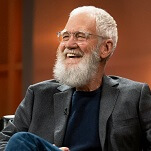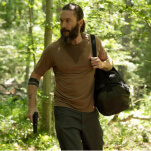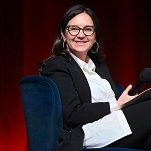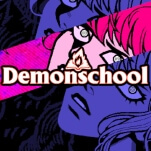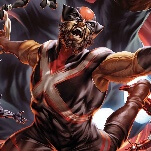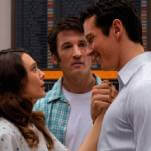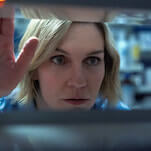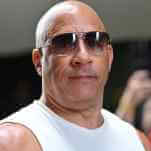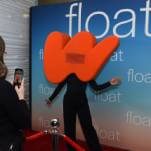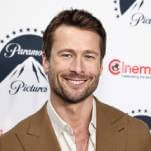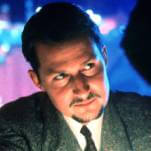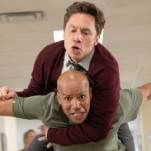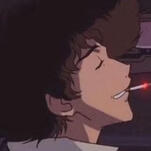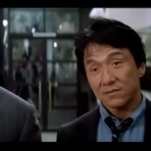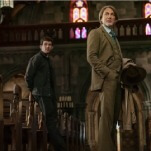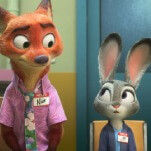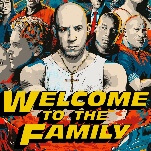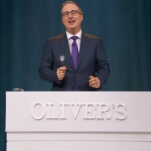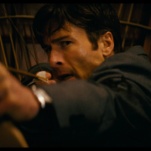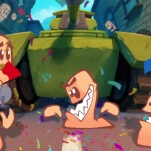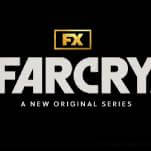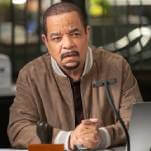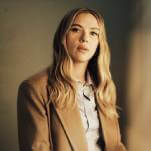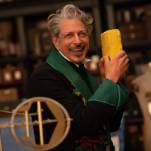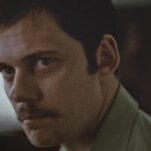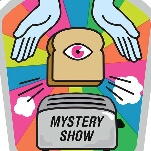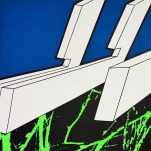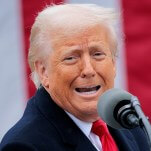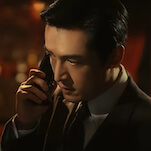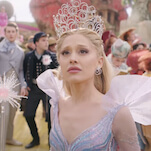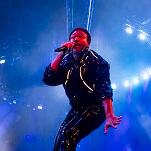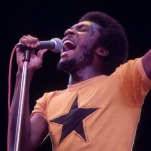Batman: The Animated Series: "Two-Face, Parts 1 And 2"
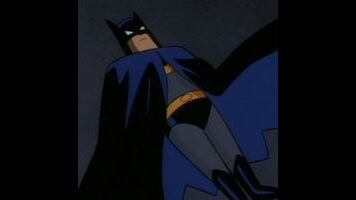
“I believe in Harvey Dent.” The phrase has become primarily associated with The Dark Knight but was first uttered in Jeph Loeb and Tim Sale’s The Long Halloween, the miniseries that served as a major influence on Nolan’s big screen take on Two-Face. Building on the underworld community established in Miller’s Year One, The Long Halloween has Batman teaming up with Harvey Dent and Captain James Gordon to take down a killer picking off members of the Gotham mafia, murders that coincide with holidays on the calendar. Much like this week’s Batman: The Animated Series two-parter “Two-Face,” Halloween portrays Dent as a valiant public figure struggling to negotiate his desire to see punishment for Gotham’s criminals with his obligation to the legal rules and procedures that he has sworn to uphold. And while Two-Face’s origin changes depending on the medium, there is one constant: Once he loses the left half of his face, there’s no Harvey Dent left to believe in.
“Two-Face” is the first instance in the series where we see the origin of one of Batman’s villains as it is happening, providing a glimpse of the human before he becomes the monster. Despite seeing their pre-rogue days through flashback, we never quite got to know Pamela Isley or Jonathan Crane, but Harvey Dent (Night Court’s Richard Moll) has been a recurring character throughout the series, establishing a personal relationship with Bruce Wayne that allows the viewer to create an emotional connection with the character. Harvey is charming and handsome, and he tries to fix Gotham’s problems without wearing a mask. He fights crime in the spotlight, but like Bruce, Harvey carries a darkness in his psyche that is waiting for the appropriate trauma to bring it to the forefront.
“Two-Face, Part One,” the first episode with a story by producer Alan Burnett, with teleplay by Randy Rogel, begins with Harvey dreaming about a shadowed figure flipping a coin with an ominous message for the District Attorney: “It’s time.” Harvey wakes up to his assistant Carlos repeating the shadowed man’s words, informing Harvey that a raid on a building owned by gangster Rupert Thorne is about to begin. With the help of Batman, the GCPD arrests a handful of Thorne’s goons, but when one of them threatens Harvey and kicks mud on his white suit, he triggers Harvey’s other personality, the insane destructive force of Big Bad Harv. Surrounded by TV crews, Commissioner Gordon prevents Harvey from doing anything that could cause any real damage to his reputation, but there is clearly something wrong with Harvey, a button that is getting easier to push.
At a Wayne-sponsored fundraiser for Harvey’s reelection campaign, Big Bad Harv comes to Bruce’s attention when Harvey is informed that the men arrested in the raid have been released from custody. Turning on the innocent Carlos and then on Bruce when he tries to calm Harvey down, Big Bad Harv is only subdued when Harvey’s fiancée Grace intervenes. The outburst is caught by Candice, Thorne’s right-hand woman, finally revealing the vital flaw that Gotham’s underworld has been trying to find on the “so clean he squeaks” District Attorney. Bruce recommends Harvey seek professional help for his problem, and despite his initial protestations, Harvey begins to see Dr. Nora Crest, where Big Bard Harv manifests under hypnosis. The first thing Big Bad Harv does? Flips the coin, of course. Dr. Crest tries to reason with Harv at first, explaining that Harvey has been bottling feelings of guilt and anger over the years until they became an illness. There’s a Bruce Banner/Hulk dynamic at work here, with Big Bard Harv considering “wimp” Harvey the lesser of the two and erupting in a fit of rage when it is suggested he concede dominance to his weaker half.
The scene in Dr. Crest’s office is one of the first truly chilling moments of Batman: The Animated Series, with director Kevin Altieri using a thunderstorm to highlight the tension between Harvey and his twisted mirror while making Big Bad Harv a truly terrifying character. When Dr. Crest asks to speak with Big Bad Harv, a flash of lightning reveals Two-Face for a split second, creating a stark black and white image that foreshadows Dent's upcoming transformation. The use of shadows in this scene heightens the intensity, and when Big Bad Harv throws the room’s only light source out the window, the darkness takes over, punctuated by thunder and lightning. Fitting, as Big Bad Harv is a storm that is constantly raging inside Harvey. Richard Moll, like Kevin Conroy, plays the duality of Harvey in his voice, giving Big Bad Harv a gravelly bass that borders on a growl, while Harvey speaks with the confidence and poise of a city District Attorney.
Big Bad Harv’s outburst is overheard by an eavesdropping Candice, who swipes Harvey’s psychological profile for her boss. Thorne blackmails Harvey with Dr. Crest’s evaluation, threatening to release the details of his split personality to the public if he doesn’t end his crusade against Thorne and his partners. This scene reveals more about Big Bad Harv’s origins, as Thorne recounts from Dr. Crest’s notes the childhood trauma that forced Harvey to create his second personality. After fighting back against a bully, Harvey was overcome with guilt after the bully had to be hospitalized the next day (for appendicitis), leading him to repress his anger for fear that he might hurt those around him. When Thorne lays his final threat down on Harvey, a gruff voice responds: “You’re talking to the wrong Harvey.” It's a completely bad-ass moment, and when Big Bad Harv throws Thorne across the room, it’s hard not to cheer for the lunatic. Harv has only one goal—kill Thorne—and his blind rage is what leads to Harvey’s transformation. With Batman occupied with henchmen in the other room, Harv chases Thorne onto a catwalk above vats of chemicals (Thorne’s hideout is an abandoned refinery for some reason). When a thug fires on Harvey, Batman tries to knock out the shooter but ends up sending a barrage of bullets into an electrical box far too close to highly explosive chemicals. The sparks trigger a blast that throws the fallen Harvey in the air like a ragdoll and scalds the left side of his body.
The friendship between Bruce and Harvey is part of what makes this episode so emotionally devastating, as Bruce ends up with another death on his conscience when he can’t stop the explosion that creates Two-Face. The friendship that Bruce has with Harvey outside the mask has an effect on how Batman approaches Two-Face, and Kevin Conroy portrays that by using the Bruce Wayne voice much more frequently when Batman is speaking. It’s almost as if Bruce is trying to confess his secret when he speaks with Two-Face. If Bruce can live a productive (happy?) life with two faces, Harvey can too. Bruce’s reaction to Harvey’s change makes me wonder how many people he has gotten close to since his parents’ deaths. Alfred, Dick Grayson, Andrea Beaumont, Harvey Dent, maybe Zatanna. Andrea leaving him was devastating, but he hasn’t had to watch any of these people be destroyed by Gotham’s evil the way his parents were. Until Harvey. And who knows where those bullets would have landed if Batman hadn’t knocked into the shooter? Bruce blames himself for Two-Face, although Harvey was damaged long before he was caught in a chemical explosion.

